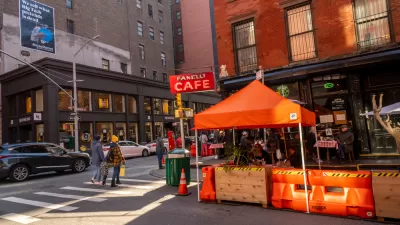Restaurant owners say they’ve been in limbo for months as city departments point fingers at each other for delays in permit approvals.

Is New York City’s outdoor dining scene dying? It appears likely, writes Chris Crowley in New York Magazine. As of January 30, just 40 of 3,700 applications for outdoor dining setups were approved by the city’s Department of Transportation.
City comptroller Brad Lander expressed “grave concerns” over “the scale of DOT’s shortcomings,” but a DOT spokesperson said one-third of applications were rejected for just causes, while two-thirds were passed on to community boards in the review process. “That does not explain the gap in approvals, however; only applicants wishing to build new outdoor structures — somewhere around 1,400 of the pending applications — need community-board approval. Applications for traditional sidewalk seating do not. So, the question is, where are all of these outstanding applications?”
According to Lander, “The DOT knew when the law was passed that they were going to have this responsibility. They knew that the applications were coming in by last August. And they just were not approved to hire up the staff necessary to approve all these applications.” Now, restaurant owners are stuck waiting to find out whether or not they should invest in outdoor seating infrastructure as the April 1 opening date for outdoor dining season approaches.
FULL STORY: Outdoor Dining’s Return Might Really Be Doomed

Alabama: Trump Terminates Settlements for Black Communities Harmed By Raw Sewage
Trump deemed the landmark civil rights agreement “illegal DEI and environmental justice policy.”

Planetizen Federal Action Tracker
A weekly monitor of how Trump’s orders and actions are impacting planners and planning in America.

The 120 Year Old Tiny Home Villages That Sheltered San Francisco’s Earthquake Refugees
More than a century ago, San Francisco mobilized to house thousands of residents displaced by the 1906 earthquake. Could their strategy offer a model for the present?

Ken Jennings Launches Transit Web Series
The Jeopardy champ wants you to ride public transit.

BLM To Rescind Public Lands Rule
The change will downgrade conservation, once again putting federal land at risk for mining and other extractive uses.

Indy Neighborhood Group Builds Temporary Multi-Use Path
Community members, aided in part by funding from the city, repurposed a vehicle lane to create a protected bike and pedestrian path for the summer season.
Urban Design for Planners 1: Software Tools
This six-course series explores essential urban design concepts using open source software and equips planners with the tools they need to participate fully in the urban design process.
Planning for Universal Design
Learn the tools for implementing Universal Design in planning regulations.
Clanton & Associates, Inc.
Jessamine County Fiscal Court
Institute for Housing and Urban Development Studies (IHS)
City of Grandview
Harvard GSD Executive Education
Toledo-Lucas County Plan Commissions
Salt Lake City
NYU Wagner Graduate School of Public Service




























